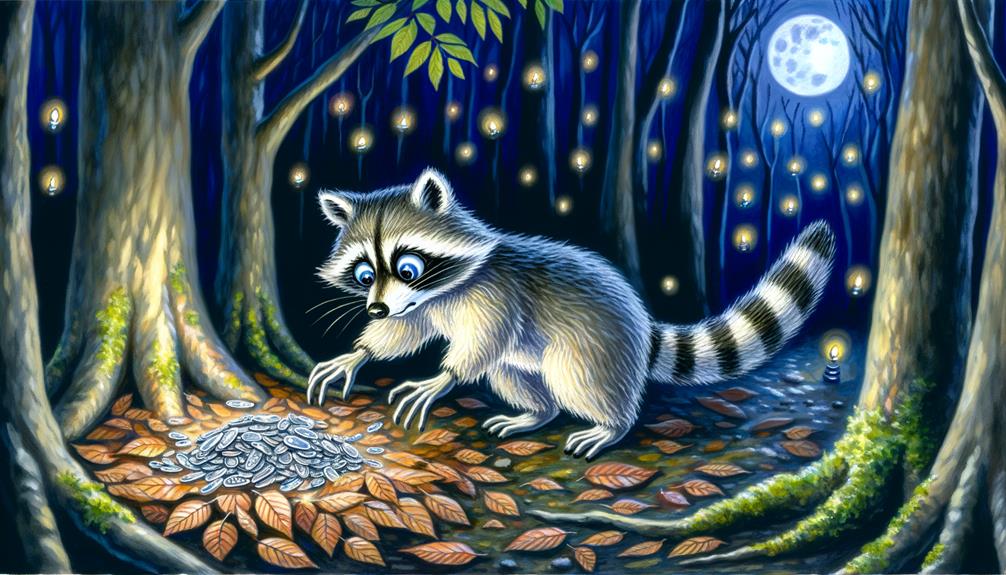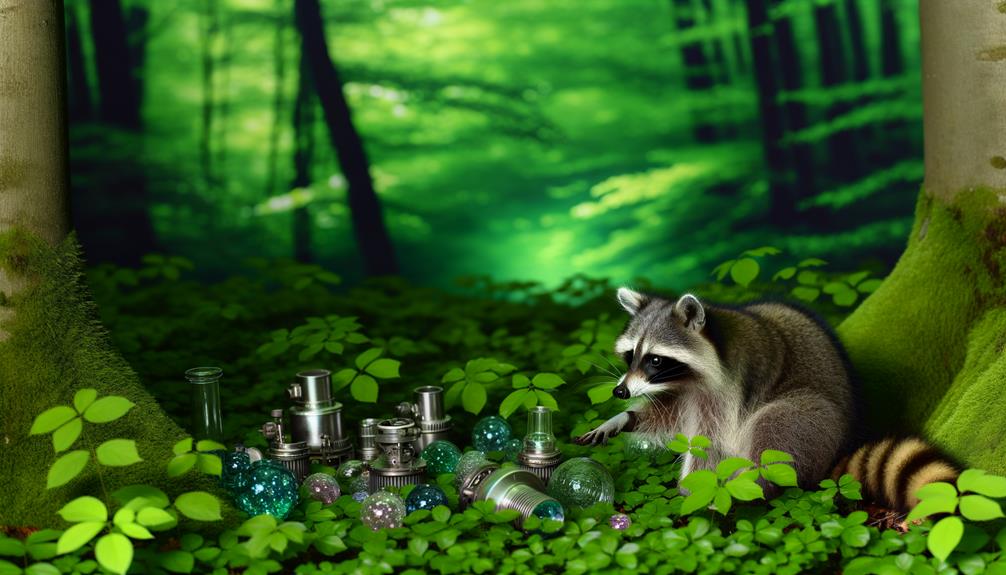How Do Raccoons Like Shiny Things?
Raccoons are naturally curious and exhibit exploratory behavior, often using their highly sensitive forepaws to investigate objects. While the notion that raccoons have a particular affinity for shiny things is largely anecdotal and lacks strong scientific support, these animals do exhibit a general interest in novel items, including reflective objects.
This behavior can be attributed to their keen tactile sensitivity and problem-solving abilities. Observations in urban environments confirm that raccoons are drawn to various objects during foraging activities.
To understand the intricacies of raccoon behavior and their interaction with their environment, further exploration is encouraged.

Key Takeaways
- Raccoons are naturally curious and attracted to novel items, including reflective objects.
- There is no substantial empirical evidence proving raccoons have a special affinity for shiny things.
- Raccoons' attraction to shiny objects is more anecdotal and culturally represented rather than scientifically validated.
- Reflective objects can stimulate raccoons' problem-solving and exploratory behavior.
- Their tactile sensitivity and curiosity drive them to manipulate and investigate various objects, including shiny ones.
Raccoon Behavior and Curiosity

How does the innate curiosity of raccoons manifest in their behavior and interactions with their environment?
Raccoons exhibit a high degree of exploratory behavior, often manipulating objects with their dexterous front paws. They engage in nocturnal foraging activities that involve meticulous examination of potential food sources, such as overturning rocks and probing crevices. This behavior indicates a robust cognitive ability to solve problems and adapt to various environments.
Their curiosity extends to human objects, frequently leading them to investigate and sometimes pilfer items from urban areas. Observational studies highlight their tendency to interact with novel stimuli, suggesting an intrinsic motivation to learn about their surroundings.
This exploratory nature not only aids in their survival but also underscores their adaptability.
Sensory Perceptions of Raccoons
Raccoons exhibit keen visual acuity, particularly in low-light conditions, which aids their nocturnal foraging habits.
Their highly developed tactile sense is evidenced by their tendency to use their dexterous forepaws to explore and manipulate objects.
These sensory capabilities collectively contribute to their attraction to and interaction with various stimuli, including shiny objects.
Keen Visual Acuity
Possessing keen visual acuity, raccoons are adept at detecting and responding to various visual stimuli in their environment. Their eyes, enriched with more rods than cones, are highly adapted for nocturnal activities, enabling them to function efficiently in low-light conditions. This heightened sensitivity to light allows raccoons to discern movement and contrasts, essential for locating food and avoiding predators.
| Visual Feature | Description |
|---|---|
| Rod Cells | High quantity; enhances low-light vision |
| Cone Cells | Lower quantity; limits color perception |
| Night Vision | Excellent; aids in nocturnal foraging |
This visual adaptability underscores the raccoon's ability to thrive in diverse habitats, from urban areas to dense forests, where their proficiency in visual detection offers a significant survival advantage.
Tactile Exploration Tendency
Demonstrating an exceptional tactile sensitivity, raccoons frequently engage in exploratory behaviors to gather detailed information about their surroundings. Their forepaws are highly dexterous, endowed with numerous sensory receptors that enable precise manipulation and assessment of objects.
This acute tactile perception is a critical component of their foraging strategy, allowing raccoons to discern textures, shapes, and even the presence of food within enclosures. Research indicates that raccoons often rely more on tactile cues than visual ones, especially under dim-light conditions.
These behaviors are indicative of their adaptive evolution, facilitating survival in diverse environments. Consequently, their tactile exploration tendency substantially contributes to their curiosity and interactions with various objects, potentially including shiny items that catch their attention through touch.
The Myth of Shiny Objects

Contrary to popular belief, the notion that raccoons are innately attracted to shiny objects lacks substantial empirical evidence. This widespread idea appears more rooted in anecdotal accounts and cultural representations than in rigorous scientific study.
Researchers have found that raccoons exhibit a general curiosity and a penchant for tactile exploration rather than a specific affinity for reflective or glimmering items. This behavior often leads to the misconception that shiny objects hold a special allure for them.
Indeed, raccoons are opportunistic foragers, and their attraction to novel items can include a variety of materials, not exclusively those that shine. Consequently, while the myth persists in popular culture, scientific scrutiny suggests a more nuanced understanding of raccoon behavior is necessary.
Real-Life Observations
In urban environments, raccoons are frequently observed interacting with various objects, including those that are reflective or shiny. Studies have documented raccoons' behaviors, noting a particular interest in items such as aluminum foil, coins, and other metallic objects.
These observations suggest a potential attraction to reflective objects, warranting further investigation into the underlying causes of this behavior.
Raccoons and Urban Environments
Numerous studies have shown that raccoons are highly adaptable creatures, thriving in urban environments where they exploit a variety of resources for survival. Observations indicate that raccoons display remarkable behavioral flexibility, allowing them to navigate human-dominated landscapes effectively.
Urban raccoons are known to:
- Forage in garbage bins for discarded food items, often creating a mess in the process.
- Utilize storm drains and sewers as safe havens and travel routes.
- Explore attics and basements, seeking shelter and nesting sites.
- Raid gardens and bird feeders, consuming fruits, vegetables, and seeds.
- Adapt to human activity patterns, becoming more nocturnal to avoid contact.
These behaviors underscore raccoons' capacity to exploit urban niches, contributing to their successful proliferation in cities.
Attraction to Reflective Objects
Field observations indicate that raccoons exhibit a notable attraction to reflective objects, often collecting and hoarding items such as aluminum foil, glass shards, and shiny trinkets. This behavior has been consistently documented in both urban and rural settings.
Researchers have noted that raccoons are often drawn to materials that emit light, possibly due to their innate curiosity and problem-solving abilities. Direct observations show raccoons frequently manipulating and transporting these objects to their dens, suggesting a possible instinctual drive to gather and store.
While the exact reasons for this attraction remain speculative, it is hypothesized that reflective objects may serve as environmental enrichment, stimulating raccoons' cognitive functions. Further studies are needed to fully understand the underlying motivations behind this behavior.
Scientific Studies

Recent research has provided significant insights into the behavioral patterns of raccoons, particularly their attraction to shiny objects. Various scientific studies have explored this phenomenon to understand the underlying motivations and sensory triggers.
Key findings from these studies include:
- Curiosity: Raccoons exhibit a high degree of curiosity, often investigating new and unusual stimuli.
- Sensory Stimulation: Reflective objects may appeal to their keen visual perception.
- Problem-Solving: Raccoons use tactile manipulation, which shiny objects may encourage due to their unique textures.
- Memory: They possess an excellent memory, recalling the location of objects previously encountered.
- Survival Instincts: Attraction to novel items could be linked to their foraging behavior, aiding in the discovery of food resources.
These studies underscore the complex cognitive and sensory capabilities of raccoons.
Attracting Raccoons Responsibly
Building on the understanding of raccoons' behavioral inclinations towards shiny objects, it is essential to explore methods to attract these animals in a way that guarantees their safety and well-being.
Utilizing non-toxic, reflective materials can spark their curiosity without causing harm. Placement of such objects in natural, non-hazardous environments minimizes risks. Additionally, providing accessible water sources and safe food options, such as fruits or specially formulated raccoon feed, encourages healthy interactions.
Importantly, avoiding human food and ensuring no entrapment scenarios are vital to prevent dependency and potential harm. Monitoring and evaluating raccoon behavior post-interaction helps refine these methods, promoting a sustainable coexistence.
This approach underscores the importance of responsible wildlife engagement, balancing curiosity with conservation.
Conclusion
The portrayal of raccoons as avid collectors of shiny objects may be more fiction than fact, yet their inherent curiosity and acute sensory perceptions do lead to interactions with various stimuli.
Observations and scientific studies reveal that while raccoons exhibit interest in diverse objects, their behavior is driven by exploration rather than an affinity for shininess.
Consequently, one can imagine raccoons, not as treasure-hunting pirates but as nature's inquisitive inspectors, meticulously examining their environment without bias toward gleaming trinkets.






